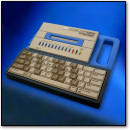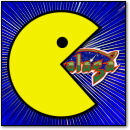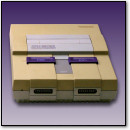Experimental Music Site Request-A-Song.com Turns 10
October 1st, 2012 by Benj Edwards
Ten years ago today, I opened an experimental music website called Request-A-Song.com. On the site, my brother Jeremy and I solicited song titles (just titles, not lyrics), which site visitors would submit via a web form. We’d pick the ones we found most inspiring and write songs based on them, then publish them on the site in MP3 format. The project lasted until December 2005.
As you might expect, a lot of very interesting and unusual songs came out of the process. You can tell just by reading the titles of our most popular songs — names like “Butter Ghost,” “Violent House Panda,” “Poke ‘Em In The Neck,” and “I Flipped My Biscuit” — that we preferred ideas on the bizarre end of the spectrum.
 In honor of our 10th anniversary, I’ve uploaded all 134 of our songs to The Internet Archive with the hope that it will preserve our effort for posterity.
In honor of our 10th anniversary, I’ve uploaded all 134 of our songs to The Internet Archive with the hope that it will preserve our effort for posterity.
You can still download those songs from the original Request-A-Song.com website (which also provides information on who requested what and when, lyrics, and dates of release), but it’s actually easier to explore our catalog with the IA’s handy online streaming MP3 app.
(If you want to know which songs to listen to first, here is a list of our 25 most popular songs.)
Over the next month, I plan on uploading more RAS information to the Internet Archive, including news archives, press clippings, song metadata, images, and more.
The Birth of Webmusic
 Launched on October 1st, 2002, Request-A-Song.com was, as far as I know, the world’s first dot-com band.
Launched on October 1st, 2002, Request-A-Song.com was, as far as I know, the world’s first dot-com band.
In other words, “Request-A-Song.com” was not only the name of the site, but also the name of the artistic group itself. I conceived it that way (around June 2000, which is telling) because I wanted the name to be a promotion for the website, and I wanted the website to be a business.
It didn’t quite work out that way. I experimented with various business models over the three years the site was active: first by selling advertising, then selling CDs and merchandise, then by opening one of the world’s earliest artist-run à la carte online music stores in October 2004 (88 cents a piece, baby!), and finally (as a last resort) by writing a few custom songs for money.
None of them generated any appreciable revenue, so I settled with being merely an artistically innovative music website. But even then, attracting listeners was tough in those days.
Online Promotion in a Different Era
 In the days before Web 2.0 hit its stride, it was an uphill battle to get noticed by the mainstream print media, which was the only real option for publicity at that time. Such publications still viewed their online presences as sideshows to the main event, and few reporters had developed identities on the web (i.e. you had to call them and speak with your voice into a telephone).
In the days before Web 2.0 hit its stride, it was an uphill battle to get noticed by the mainstream print media, which was the only real option for publicity at that time. Such publications still viewed their online presences as sideshows to the main event, and few reporters had developed identities on the web (i.e. you had to call them and speak with your voice into a telephone).
That situation is very hard to imagine now, but consider this: in 2002, the most popular community sites were bulletin board-style web forums. Outside of that, you had to pay to get heard. (Or pray you’d get Slashdotted.)
In other words, imagine trying to promote your personal project online today without mainstream blogs (which hit it big in late 2004), Twitter, MySpace, Facebook, YouTube, Digg, or Reddit. You couldn’t even post a single comment on a news story or “share” a single item with a friend. What would you do?
 Most of the money I spent on RAS went directly to advertising on Something Awful. I also bought a few ads on Friendster in 2004 after it became moderately popular, but those were very expensive. I released press releases through news services to little impact.
Most of the money I spent on RAS went directly to advertising on Something Awful. I also bought a few ads on Friendster in 2004 after it became moderately popular, but those were very expensive. I released press releases through news services to little impact.
I also tried releasing songs (all requests, of course) tied into contemporary events and Internet memes to gain attention. Hence titles like “Traumatized by Goatse,” “I Saw Janet Jackson’s Boob,” and “Ellen Feiss Makes Me Hot.” That effort resulted in more one-time visitors, but not long term listeners.
(Amusing tidbit: One of my best unreleased songs is called “Be My Friendster.” By the time I finished it, people had moved to MySpace.)
Ironically, none of those old school efforts would equal the impact of one single well-placed free blog post a few years later. But that’s what you get for being early to the party.
What’s an MP3? Is it Pirated?
 Even if I managed to get the message out, most potential listeners were still unclear about how music through the computer worked.
Even if I managed to get the message out, most potential listeners were still unclear about how music through the computer worked.
Very few people over the age of 20 had even attempted to listen to an MP3 in 2002, and I remember having to explain in fine detail to people about how they could download and hear our songs. It was a painful experience for many who were still stuck with dial-up Internet connections.
When they did listen to our music, they usually did so on the crappy, tiny $10 speakers that were typically hooked up to PCs at the time. It was an aggravating experience for someone trying to create quality audio productions.
In late 2002, iPods still only worked with Macs, so very few people owned them — or any MP3 player. The iTunes Music store hadn’t opened yet, either, which brings me to another point.
 Because of the Napster file sharing controversy that hit in 2000, “online music” meant “pirated music” to most people at that time. Legal music downloads were by no means mainstream.
Because of the Napster file sharing controversy that hit in 2000, “online music” meant “pirated music” to most people at that time. Legal music downloads were by no means mainstream.
One particular web hosting service threatened to pull the plug on Request-A-Song.com in its first month because of its blanket “no MP3 files” policy. I had to call them on the phone and carefully explain that our MP3 files were, in fact, recordings of songs that we wrote and owned ourselves.
It’s a good thing I did, because there would be a lot more where that came from.
Many Things a Week

In its early months, Request-A-Song.com quickly gained attention for the speed at which we produced new songs — and for the resulting volume of music that resulted. Such a rapid release rate of non-demo quality songs from a single artist was unprecedented at that time.
We wrote a lot of songs. (Especially me, personally — I was responsible for 100 of the 134 songs on the site.)
For the first six months of the site, we released at least eight songs a month. In April 2003, I was a bit burned out, so we did only one song. Then we released at least six songs a month for the next four months. Finally, I decided to — get this — reduce our workload by lowering the song release rate to one a week.
 One a week. On September 8, 2003, we announced our “New Song Every Wednesday” program. Between September 10, 2003 and July 14, 2004 — a 41 week stretch — we released one new song every Wednesday.
One a week. On September 8, 2003, we announced our “New Song Every Wednesday” program. Between September 10, 2003 and July 14, 2004 — a 41 week stretch — we released one new song every Wednesday.
I was amused when I first heard of Jonathan Coulton’s “Thing a Week” in 2005, and you might be able to understand why. (I was also amused by his music — because it is great.)
Sure, we didn’t do it for the tidy 52 weeks back-to-back like he did, but if you average out the 76 songs we did do in our first year, that’s 1.461538461538 songs a week! (My precision here, while accurate, is an attempt at humor.)
At one point, I was creating songs so fast that I would record a song, wake up the next day, and I couldn’t even remember how it went. I would fire up the recorder and listen, amazed — it was like hearing the song for the very first time.
A few songs, like The Evil Toucan Sam, had a less than one day turnaround time. I received the request in the morning, recorded it in the afternoon, and released it to the entire world at night. Such a pace would have made John Lennon in his Instant Karma days envious.
The Music Itself
 Amid talk of all this creative output, the question remains: Were the songs any good?
Amid talk of all this creative output, the question remains: Were the songs any good?
I think so. There’s some amazing music hidden in that 134 song archive. But I would think that, wouldn’t I?
I remember that listeners and the press alike were amazed at the quality of the output as coming from our independent two-man operation on the Internet for at least the first year. (You can always judge for yourself by listening to the music.)
But of course, with that many songs released so quickly, we had our fair share of stinkers.
I personally tried to turn around songs as fast as possible (in one or two days), so I typically created relatively sparse productions with an eye on quantity over quality at times. My brother Jeremy preferred to refine his songs over the course of weeks, so they tend to sound like typical high-end pop productions. Between us, we probably made at least 40 really good songs, 70 good/decent ones, and 20 that aren’t that great.
 I’m proud of that record. In the liner notes of our first CD release in 2003, I wrote of my attempt to create music as a service. I predicted an era when, if you wanted new music, you’d have it created for you and you’d download it on demand from sites like RAS on the web.
I’m proud of that record. In the liner notes of our first CD release in 2003, I wrote of my attempt to create music as a service. I predicted an era when, if you wanted new music, you’d have it created for you and you’d download it on demand from sites like RAS on the web.
In a very limited sense, that has come to pass with audience interaction through YouTube and the availability of almost endless new music from independent musicians around the world.
It’s easy for those artists now, compared to the RAS days, to get their stuff out there. But it’s much harder to stand out among the billions, so I am glad that RAS stopped when it did. Honestly, if I had started the project three years later, it may have been nothing special.
But it started in 2002, and it was incredible for its time. Happy birthday, Request-A-Song.com.







October 4th, 2012 at 10:27 pm
and the site is still alive!
wow… that is cool. congrats!
October 6th, 2012 at 12:52 pm
Wow, I have never seen or heard of this web site before even as an Internet addict!
October 12th, 2012 at 9:47 pm
I still have “Chainsaw Paladin” on my IPhone. My husband still has a lot in his collection as well.
November 9th, 2014 at 7:34 pm
I just spent a lot of time browsing the songs. My ears hear a lot of TMBG influence, which is great. Great work.
November 10th, 2014 at 8:53 am
Thanks Mr. Aquarius (May I call you Mattel?). I’m glad you like the music.